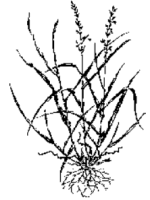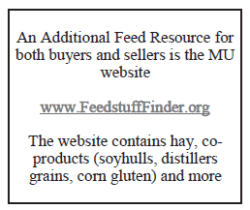

To send a message to an author, click on the author's name at the end of the article.
This Month in Ag Connection | Ag Connection - Other Issues Online

Tall fescue, a common pasture forage stockpiled for winter grazing. It is often infected with endophyte, a toxic fungus that produces ergovaline which has negative effects on livestock health and productivity. One effect of the toxin is constriction of the blood vessels, reducing blood flow to the extremities of the livestock consuming the forage. As a result, cattle grazing infected pastures often have a rough hair coat, may lose the switch of the tail, may become lame, and may exhibit heat stress even when the temperature is not excessive.

Grazing management can help reduce the negative impact of ergovaline on livestock. University of Missouri research found the concentration of ergovaline is very high at the base of endophyte infected tall fescue plants. Leaving a four-inch stubble when grazing, will reduce the amount of toxin cattle consume. It was also documented that in autumn following a summer drought, the endophyte concentration in the bottom four inches of the tall fescue plant was even higher than normal.

Leaving a four-inch stubble when grazing stockpiled tall fescue will also encourage growth early the following spring. Pastures grazed very short during autumn and winter will be slow to begin growing because the carbohydrates needed for green up in the spring are stored at the base of the fescue plant. Maintaining the four-inch stubble will leave sugars in reserve for growth when the plant breaks dormancy in spring.
Source: Valerie Tate, Agronomy Specialist
This Month in Ag Connection | Ag Connection - Other Issues Online
Resiliency begins with awareness and planning. The recommendations in this article will improve financial resilience in the event of a disaster, but also have application for general personal and business operations.
Before a Disaster
Contribute regularly to an emergency savings account even if the amount is small. Make a budget to estimate monthly income and expenses. Reduce debt by making payments of at least the minimum due and pay bills on time to maintain or improve credit ratings.
Review insurance coverage annually including property, liability, crop, livestock, health, life and others. Protect property by taking photos and videos of household items and business assets in case there is a need to repair, replace, or rebuild after a disaster.
Create and update an emergency plan. One planning tool is the Emergency Financial First Aid Kit (EFFAK) as a guide which can be found at https://www.fema.gov/emergency-financial-first-aid-kit. This plan focuses on identifying not only income and expenses, but contact information for items such as bank, employer, insurance, etc. and the location of these items.
Store important records and receipts in a waterproof, fireproof container and/or store digitally. While some items can be stored in a safe deposit box, access to that box is restricted and if the box holder is unavailable, or if the existence of the box is unknow, then this becomes a hurdle for quick access.
Keep cash in a secure place in case of an emergency and the Automatic Teller Machines (ATMs) are not available. Businesses may be unable to transact with credit or debit cards in the short-term.
Switch from paper to electronic payment for federal benefits or employer pay to keep receiving in the event a paper copy could not be delivered or is stolen.
Utilizing a qualified financial counselor or accessing online tools may be helpful when preparing for a disaster. Some nonprofits provide this service, but these are very limited in rural areas. Mu Extension can assist you in accessing resources for calculating, organizing and planning.
During a Disaster
Use emergency savings for purchasing essentials like food, gas, and temporary lodging. Even with public assistance, there will always be a gap or immediate need for cash.
Contact credit card companies and lenders to negotiate payment options to avoid late penalties, interest charges, and damage to credit scores.
Contact community organizations (food banks and faith-based organizations) for assistance to help cover daily essentials and connect to additional resources.
After a DisasterLog onto DisasterAssistance.gov to find qualifications for financial disaster relief. Visit a local Disaster Recovery Center for important resources for relief by FEMA and community and faith-based organizations.
There are different types of disaster declarations, so to receive assistance specifically for agriculture, it should be an Agricultural Disaster Declaration with aid coming through the Farm Service Agency.
Make a list of all property damage and contact the insurance company as soon as possible. Also report agricultural damage to the local Farm Service Agency.
File an insurance claim and work with the insurance adjuster and agent through the process. Floods are the most common natural disaster in Missouri and the United States. Homeowners and rents should know most policies do not cover flooding without special provisions. It is also relevant to know most insurance policies take 30 days to go into effect, so read the policy details and be proactive.
Be extra cautious of scams after disasters. Do not give out personal identification numbers such as Social Security and bank accounts.
Prioritize spending and take inventory of credit cards. Create a list to get all information in one place, understand spending needs, and protect credit.
There may be tax breaks based on the situation.
Turn off utilities to save on expenses if residence is unlivable.
Utilize more of FEMA's resources by going to Ready.gov/financial-preparedness.
Source: Darla Campbell, Business & Community Specialist

This Month in Ag Connection | Ag Connection - Other Issues Online
During the holiday season, decorated trees, twinkling lights and familiar carols create a festive atmosphere. Some plants play key roles as well. Church altars are adorned with poinsettias, mistletoe hangs over doorways, and holly is used in floral arrangements.
The poinsettia, the most popular holiday plant, was introduced into the United States by the first United States ambassador to Mexico, Joel Roberts Poinsett. He had poinsettias sent to his home in Greenville, South Carolina in 1825 where he began propagating the plants in his greenhouses on his plantation. He sent poinsettia plants to friends and to botanical gardens.
Today, poinsettias come in many colors and forms. New selections appear in the market every year. An interesting point about poinsettias is the flowers. The true flowers are small, green and yellow and inconspicuous. The showy red parts, often called flowers, are not parts of the flower. They are modified petal-like leaves, called bracts. The bracts are formed below each flower. When caring for a poinsettia, place it in a well-lit room away from a drafty window. Water the plant when the soil feels dry to the touch. Do not over-water it, as this can lead to root rot and death of the plant.
Holly adds visual interest to a landscape in winter months. The holly most commonly used in holiday decorations, due to its' striking evergreen foliage, is English holly (Ilex aquifolium) and American holly (Ilex opaca). Holly plants come in all sizes, ranging from spreading dwarf holly shrubs 6 inches in height to holly trees 70 feet tall. Shapes vary from rounded to pyramidal to columnar. All holly trees and shrubs are dioecious. Male and female plants must be planted within 30- 40 feet of each other for berry production.
Mistletoe is a flowering plant that obtains its' nutrition by living on and parasitizing other plants. By parasitizing a host plant, mistletoe has a competitive advantage over many other forms of life because it does not have to compete in soil for water and nutrients. Mistletoe originated in the tropics where soils are typically poor in nutrition and competition within the soil between plants and microorganisms is fierce. The berries of mistletoe are poisonous.
Christmas trees have been sold commercially in the United States since 1850. During the depression, nurserymen could not sell evergreens for landscaping, so the evergreens were cut for Christmas trees. Cultivated trees were preferred to wild trees due to the more symmetrical shape. Approximately 26 million Christmas trees are produced each year. The bestselling trees are Scotch pine, Douglas fir, Noble fir, Fraser fir, Virginia pine, Balsam fir and White pine. Christmas trees take an average of 7-10 years to mature. Ever since the first Christmas tree retail lot was set up on the streets of New York City in 1851, Americans have been enjoying the tradition of a live tree to celebrate the holiday season. With the proper selection and care, consumers can enjoy a fresh tree throughout the holidays.
Source: Jennifer Schutter, Horticulture Specialist
This Month in Ag Connection | Ag Connection - Other Issues Online
This Month in Ag Connection | Ag Connection - Other Issues Online
Each year the University of Missouri Variety Testing, tests over 600 corn, grain sorghum, wheat and soybean varieties at 32 locations throughout Missouri.
The 32 locations are distributed among four regions: North, Central, Southwest and Southeast. The number of locations within a region depends on the specific test but varies from two to five. Companies enter their varieties into tests at one or more of these regions, but the entries must be placed at all locations within a region.
The headquarters for the MU Variety Testing Program is the Bradford Research and Extension Center located east of Columbia, MO. In addition, there are personnel located at the Delta Research Center near Portageville. The majority of the test locations are farmer fields. The farmer cooperators are essential to make this program work and are greatly appreciated.
For many years the results were distributed in book form to county extension centers. The results are now distributed online. If you need a few printed pages check with your county extension center.
The 2024 results can be found on online at: https://varietytesting.missouri.edu/.

Publishing Information
Ag Connection is published monthly for Northeast and Central areas of Missouri producers and is supported by the University of Missouri Extension, the Missouri Agricultural Experiment Station, and the MU College of Agriculture, Food and Natural Resources. Managing Editor: Mary Sobba.